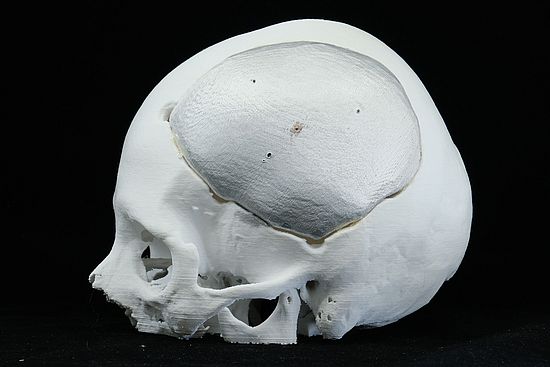Tough Resin Material Details

General Informations
Tough2000 is a resin material designed for Stereolithography 3D printing, abbreviated as SLA. This material was created to emulate the characteristics of thermoplastic polypropylene (PP). In its raw form, Tough2000 is a liquid substance that solidifies (polymerizes) using UV laser technology. Parts produced using SLA technology are distinguished by their exceptionally smooth surface finish and high precision. Due to the UV curing process used to create Tough2000, these components are slightly more brittle compared to thermoplastic PP and lack meltability. Nevertheless, the material exhibits a degree of flexibility, high yield strength, and elongation at break.
Large Components: Tough2000 can be processed in large-scale machines, allowing for the fabrication of parts up to 2 meters in size.
Ideal for Water Applications: SLA-printed components benefit from high density and water resistance, making them suitable for use in swimming-related applications and water flow tests. The exceptional surface quality also lends itself well to wind tunnel testing and fluid dynamics analysis.
Weather Resistance: SLA parts, in general, are not weather or UV resistant and are often used for prototyping purposes. Components made from Tough2000 Resin are best suited for environments protected from outdoor elements.
Support Material: In SLA 3D printing, the support material is the same as the printing material and must be manually removed, which may affect design flexibility compared to other manufacturing methods.
Post-Processing: SLA parts can undergo high-quality post-processing, allowing for the addition of fine details (down to 0.05 mm) and sharp edges. With appropriate post-processing, such as painting or coating, these parts can also be used for long-term applications.
Rinnting in tough resin
Minimum Wall: 0.3 mm
Smalest Detail: 0.05 mm
Layer hight: 0.05 mm
Max Print size:145 × 145 × 185 mm
Tollerance: 0.2% min ±0.15 mm
Delivery Times: Typicaly 5-8 Businessdays

Pro`s and Con`s
Pro:
- Extremely Smooth Surface: PP-like Resin produces parts with an exceptionally smooth surface finish, making it ideal for applications where aesthetics and precision are crucial.
- High Precision: This material offers outstanding dimensional accuracy and the capability to produce fine details, making it suitable for intricate designs.
- Very Small Details Possible: PP-like Resin allows for the creation of very small and intricate details in your 3D prints.
- High Yield Strength and Elongation at Break: The material exhibits high yield strength and elongation at break, ensuring that your printed parts maintain their shape and structural integrity.
- Flexibility (for Snap-Fit Applications): PP-like Resin offers flexibility, making it suitable for applications with snap-fit connections.
Con:
- Low UV Resistance: PP-like Resin is not resistant to UV radiation, which can lead to degradation when exposed to sunlight or UV sources.
- Not Weather-Resistant: It is generally not suitable for outdoor use or in environments exposed to the elements due to its lack of weather resistance.
- Manual Removal of Support Material Required: In SLA 3D printing, the support material used is the same as the printing material and requires manual removal, which can be time-consuming.
- Very Low Heat Resistance: PP-like Resin has very low heat resistance and is not suitable for applications where heat resistance is required.
Applications of Tough Resin 3D Print



Applications of Tough2000 Resin 3D Printing
Tough2000 Resin, with its unique properties, finds applications across various industries. Here are some common use cases:
- Injection Molding Prototypes: Tough2000 Resin is ideal for creating prototypes that accurately simulate injection-molded parts, aiding in the design and testing of molds.
- Electronics Components: This material can be used to produce durable electronic components with intricate designs.
- Small and Miniature Parts: Due to its fine detailing capabilities, Tough2000 Resin is perfect for crafting small and miniature parts used in various industries.
- Functional Prototypes: Tough2000 Resin can be used to create functional prototypes that require strength and precision.
- Haptic and Optical Product Samples: It is commonly used for producing haptic (tactile) and optical (visual) product samples for design and marketing purposes.
- Simulation: Tough2000 Resin's high precision and strength make it suitable for simulating the performance of injection-molded components, conducting form and fit checks, and evaluating prototypes for various applications.
Thanks to its remarkable precision and strength, Tough2000 Resin is a valuable material for a wide range of applications, including those requiring durable and detailed 3D-printed parts.
Technical specifications
Mechanical and Thermal Properties:
Property | Value |
Tensile Strength (ASTM D 638-10) | 33 MPa |
Tensile Modulus (ASTM D 638-10) | 1.5 GPa |
Elongation at Break (ASTM D 638-10) | 51% |
Flexural Modulus (ASTM C 790-10) | 1.4 GPa |
Notched Izod Impact Strength | 67 J/m |
Heat Deflection Temp @ 1.8 MPa | 45 °C |
Heat Deflection Temp @ 0.45 MPa | 52 °C |
Solvent Compatibility:
Solvent | 24 hr weight gain (%) |
Acetic Acid, 5% | 0.75 |
Acetone | 19.07 |
Isopropyl Alcohol | 3.15 |
Bleach, ~5% NaOCl | 0.62 |
Butyl Acetate | 5.05 |
Diesel | 0.11 |
Diethyl Glycol Monomethyl Ether | 5.25 |
Hydraulic Oil | 0.17 |
Skydrol 5 | 0.46 |
Hydrogen Peroxide (3%) | 0.71 |
Isooctane | 0.02 |
Mineral Oil, Light | 0.05 |
Mineral Oil, Heavy | 0.09 |
Salt Water (3.5% NaCl) | 0.66 |
Sodium Hydroxide (0.025%, pH=10) | 0.7 |
Water | 0.69 |
Xylene | 3.22 |
Strong Acid (HCl Conc) | 4.39 |



